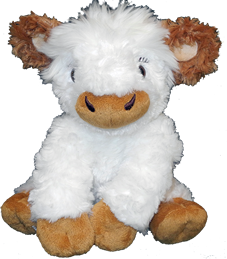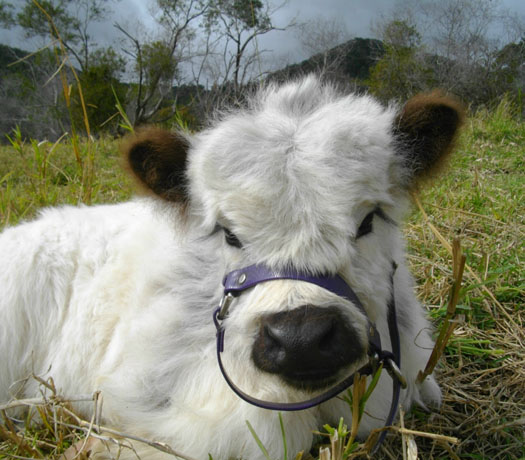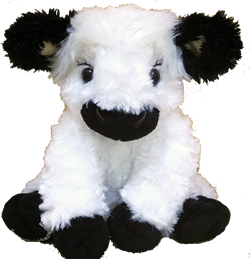caring for miniature cattle
Owning miniature cattle has proven to be one of the best decisions we have made in a long, long time. If you are a first-time livestock owner, you will learn as you go - we certainly did. At times, the learning curve will seem steep but eventually, it will all become second nature. A pattern will evolve where you just know what you need to do for your miniature cattle and your cattle will know what they need to do for you. Cattle love a routine and a bit of peace and quiet - just like us really.
Starting Out
Which One to Choose - Bulls, Cows, Heifers or Steers?
The following information is provided for the first-time livestock owners as a starting point only.
First and foremost, think carefully about why you want miniature cattle. What do you expect from the cattle? What kind of cattle do you want and why? Have you considered what the cattle will need from you? What are you prepared to provide your cattle to keep them happy and healthy.
The lifespan of well looked after cattle can be 25 -30 years or more. So it is worth a bit of thought.
To begin with, you need to appreciate that cattle are herd animals, so you need to have at least two. Some miniature cattle are content to be paired up with other animals - sheep, alpacas, goats, donkeys and even miniature pigs. Other miniature cattle are better suited to being part of a herd of cattle (even if it is a small herd).
Steers: Castrated male cattle (testicles removed). Usually castrated quite young so that the little fellow remains small and docile. We generally recommend a couple of steers for first-timers.
Heifers: Young female cattle that have not had their first calf. We recommend heifers to people wanting to enjoy the little girls now while they 'learn the ropes'. Then they can enjoy their new calves a bit later on.
Cows: Mature female cattle that have had their first calf. We generally recommend cows to people who want calves sooner rather than later. Buying the cow pregnant is a good option. Galloway cows calve well into their teens (some are having calves at twenty-odd).
Bulls: Male cattle that have not been castrated. We don't recommend bulls to first timers unless you want to breed and have at least a small herd.
Steers, if you get them at six months old, are the easiest to manage. Steers don't go looking for cows or heifers in-season (also called 'cycling' meaning the female is hormonally ready to join with a bull). If you have cows and bulls you will soon discover that their drive to join with a mate can be very strong and usually very inconvenient. Your neighbour will only ring you at the most inconvenient time to let you know that your bl#ody bull is in with his show heifers! (Or worse - out on the road!!)
So, unless you have enough cows to keep a bull entertained you are better off making other arrangements (no, as a rule, one or two cows won't do it!). There will always be exceptions to any rule and our little bulls are proving to be quite content to stay exactly where we put them. As long as they have the company of at least one steer, our little bulls seem fine.
Also: Unless you are able to borrow a bull or pay to have your cows artificially inseminated, a cow that is cycling may go wandering in search of a bull. They usually don't wander quietly and they can be very determined. Again, there are always animals that seem perfectly content regardless. Our females have not gone through a fence or caused a big fuss to date (touch wood).
Our Galloway cows are renown for ease of calving. If you want to experience the joy of your very own calves there is no reason why you should not buy some 'girls'. Make sure you will have enough feed for the calves as they grow and that you have a plan for their future. You need to know what you are going to do with the calves by the time they turn six months old.
Some miniature cattle mature very early - both bull calves and heifers. You may need to separate males and females at a young age to prevent unwanted pregnancies. To avoid calving problems, it is a good idea to let little heifers grow out a bit before allowing them to join with a bull.
Caring For Miniature Cattle - The Basics
Again, this information is provided for the first-time livestock owners as a starting point only. Basically, miniature cattle need pasture, shade, fresh water, ongoing care and regular contact with their owner.
Pasture: Pasture is the mixture of different grasses, legumes etc that are in your paddock. The greater the variety of grasses and legumes in your paddock the better the nutritional value the pasture has for your cattle. It is probably wise to seek local knowledge on the type of lantana and other weeds you may have on your property that are poisonous to cattle. Talk to your vet or a farmer who lives near you about these things.
Paddocks & Fences: You need at least three paddocks so that the pasture can be rested and the cattle get a fresh paddock regularly. Alternatively, if you only have one large paddock you can divide it into three. You can easily use inexpensive electric fencing to divide up one paddock. A small battery-powered transformer and PVC tread in posts with a strand of poly wire is all you need. The transformer is no bigger than a 1 litre milk container and‚ can be‚ run on D cell or 12 volt batteries. Transformers are under $200 and the white tread in PVC posts are around $6. Too easy.
Boundary fences need to be well maintained and strong enough to contain your biggest, most adventurous animal. Four or five strands of wire, barbed or plain, with star pickets and timber corner posts and stays, should be sufficient. Most cattle won't test fences if all their needs are being met. Barbed wire is not necessary and is harmful to wildlife. If your fences already have barbed wire please consider replacing the top and bottom strand with plain wire - especially if it is evident that you have a wildlife corridor.
Shade: Shade means mature trees that the cattle can't wreck or at least a solid shade structure where cattle can get out of the sun in each paddock. Make sure the shade is always available in the middle of the day in every paddock. Our Wee White cattle have a double coat and don't need shelter from the cold, definitely not in Queensland anyway, but they do need shade. Shade for the cattle in the middle of the day is a must and it is a bonus if their water can be in the shade.
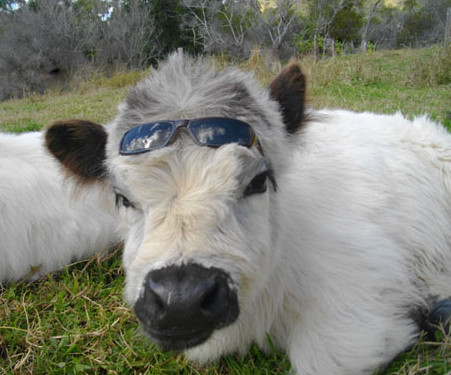
No, they don't need sunglasses but we do love to have a bit of fun in the paddock with the cattle.
Fresh Water: Fresh water means that the cattle need a trough in the paddock that is monitored and topped up regularly or an automatic trough (you still need to check an automatic trough occasionally to see that it fills properly). Ideally, the container needs to be deep enough for the water to stay cool or to be shaded in the heat of the day. If the cattle have access to a dam or pond that is fine - as long as you don't mind the water being fouled and the edges being eroded.
Contact and Care: At least once or twice a week, look carefully at your miniature cattle and run your hands all over them. By doing this you will remain familiar to your cattle and you will be able to notice when things change. You will be able to take note of the condition of the animal and their coat. You will also notice things like too many ticks, flies or odd behaviour.
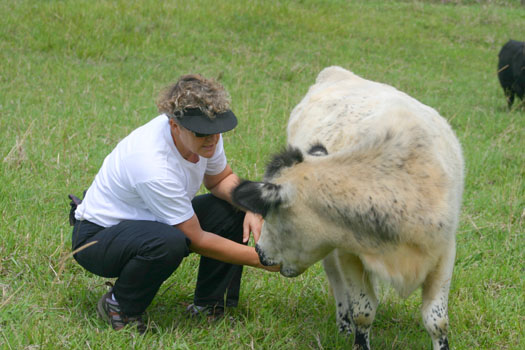
Check your cattle regularly and then you'll know when something is not quite right.
If you notice your miniature cattle are losing condition (getting skinny) you need to add extra hay or other feed to supplement their pasture. If they are getting too fat you might want to cut back on the extras or put them in a 'Jenny Craig' paddock.
The more time you spend with your miniature cattle the easier it is to train them or to do anything else with them for that matter.
We brush the cattle because we enjoy doing it. They love it - but they don't need to be brushed.
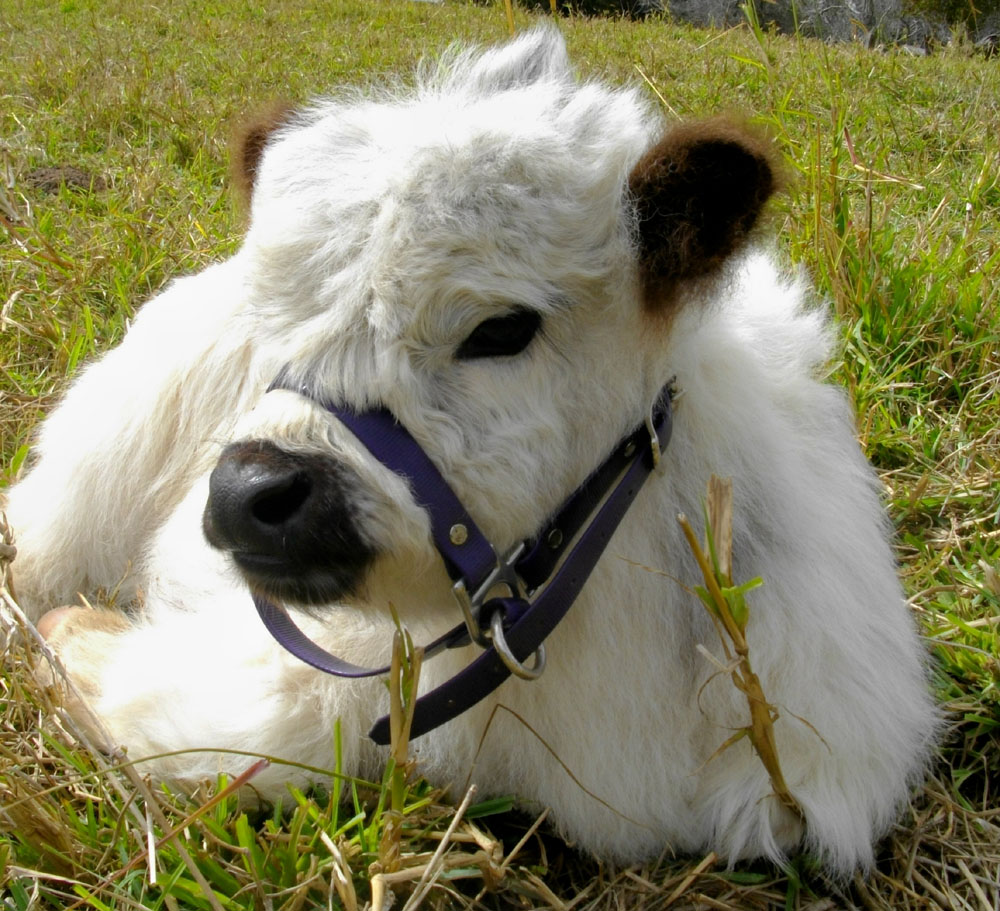
Halters are easier to introduce if calves are used to you touching their faces.
Treating for Internal and External Parasites & Bugs
Cattle Lice: In southern NSW we have learned that locals treat their cattle for lice in April and August every year. We tried this the first year. But have discovered, for one reason or another, the lice don’t stick to the timetable. So keep an eye on your cattle and if you notice they are rubbing themselves more often than usual or looking irritated when licking at their sides treat them immediately. We use a pour-on on our cattle because it is easy and effective. We put a pour-on down the back of the cattle. We did it in mid-July in 2018 because the cattle were obviously irritated and we could see the lice eggs and the lice themselves. We did the whole herd again six weeks later in August because some lice were still there on some cattle.
In treating lice we have chosen to use Ivomec because it seemed to be the most effective and didn’t have the obnoxious chemical smell all too obvious in other pour-on brands we have tried. When we handle the cattle daily it is important to us that they don’t stink.
We have also used Cydectin as the regular pour-on drench, but with our cattle, the Ivomec was more deadly on the cattle lice.
Most pour-on drenches are used for the treatment and control of gastrointestinal roundworms, eyeworm, sucking and biting lice, sarcoptic and chorioptic mange mites, buffalo fly and cattle tick in cattle, and for the treatment and control of gastrointestinal roundworms and lungworm of red deer.
Cattle Ticks & Parasites: In the hotter months of the year, if you live in a tick zone, keep an eye out for the appearance of cattle ticks on your miniature cattle (most of Eastern Australia). If ticks become a problem you will need to use a pour-on or spray product to control the tick numbers. Most of the pour-on products you use for ticks also treat internal parasites. So, even if you don't have ticks, the cattle will still need a product like Ivermectin, Cydectin or something similar periodically to treat worms and other internal parasites.
Nearly all tick products need to be applied every three or six weeks when ticks are in high numbers. With our cattle we simply walk up to them in the paddock and pour Cydectin along their back. This means no herding them into yards, no need for a crush and no hassles.
You can purchase smaller bottles (smaller than cattle stations use), of these products at Landmark, a produce store or the like. You pour a measured amount down the spine. There is a tape you can use (like a dressmaker's tape) to work out the weight of the animal so you know the correct amount of pour-on you need to use. These tapes are also available from Landmark, a produce store or the like.
If you only have two miniature cattle and you brush them regularly with a slicker brush, a chemical tick treatment may not become necessary. We brush our cattle every few days, move them into a fresh paddock every two or three weeks and then slash the pasture behind them.
In January 2010 our cattle only had a couple of ticks on their ears after months of no other treatment. We were then hoping that during the next season we will only need to use Neem Cattle Wash to control ticks. Unfortunately, extreme weather conditions in early 2011 put that on hold. Queensland experienced so much rain it was difficult to know what to do with the cattle most of the time. The cattle coped very well and we need not have worried but we did have to go back to using chemicals to control the outbreak of ticks that has followed.
Paralysis Ticks: Cattle ticks and paralysis ticks are two different ticks. Cattle tick products do not stop paralysis ticks from attaching. If you have very young, small calves (younger than 3 months old) check them for paralysis ticks just like you would a dog. Miniature Galloway calves are only the size of the medium and large dog breeds until they are 4-5 months old. You could rinse the calves in Fido Tick Rinse or Permoxin regularly to protect them from paralysis ticks until they are bigger. Or you could just put a tick collar on them. We do this in the drier months and it has proven to be very effective. Paralysis ticks won't kill larger calves but you still need to keep an eye on them and remove ticks when you find them.
Paralysis ticks can be found all along the coastal areas of eastern Australia. Where ever they are a problem for dogs they will be a problem for miniature calves.
Buffalo Fly: Again, in the hotter months of the year, look out for buffalo fly. These small flies hang around and irritate the cattle's eyes in particular - sometimes making them bleed. If they become a problem use a product like Brute, a pour-on, works well for people with small numbers of cattle. You might be able to purchase a couple of ear tags from a neighbour who uses these to protect their cattle from buffalo fly.
If you want to use non-chemical or organic alternatives there are a few available. We use and can recommend Neem Cattle Wash. We dilute it and spray it on (using a little 500ml kitchen spray bottle) to kill tick larvae, deter buffalo fly and soothe any skin irritations. We also use it neat on cuts, scratches, sores and bites. Check it out online. We use Lucas Paw Paw ointment on broken skin and the corners of eyes that have been bothered by flies. We have started using homoeopathic drops for Buffalo Fly and are now waiting to see the results next season (homoeopathic drops from Heal With Ease).
Ongoing Maintenance
Get to know other people in your area with cattle. We have found that 'cattle people' are really helpful people. They usually don't mind being asked what you might feel are 'silly questions'. If you can team up with a couple of other people, who also have miniature cattle, it can help immensely. You get the opportunity to share information, ideas, costs and worries.
Most of the annual vaccinations, injections, drenches and the like come in packs of 10, 20, 40 etc. So it is really helpful if you keep in touch with other cattle owners so you can organise to share these packs. Things like Cydectin come in many different sizes, but the larger the volume you buy, the more you can cut the cost per litre. Even buying twice as much and halving it with friends really helps to keep costs down.
More importantly though, by finding other people with miniature cattle, you get to share the sheer joy of owning these wonderful animals with other people, people who actually understand what you are so excited about.
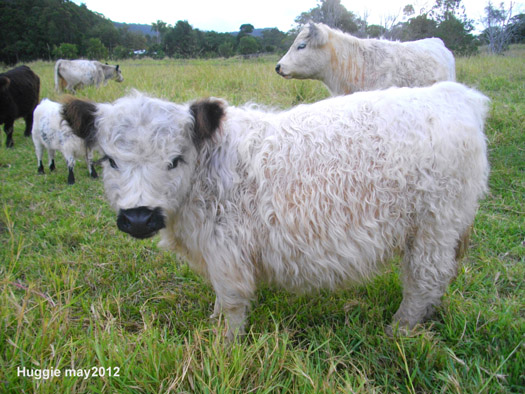
Vaccinations and Injections: Cattle need an annual 7 in 1 injection. The 7 in 1 injection is an immunisation against enterotoxaemia, blackleg, malignant oedema, black disease, tetanus and leptospirosis. You may choose to use other injections to solve other problems.
Bovine Ephemeral Fever: An annual Bovine Ephemeral Fever (BEF) injection will immunise your cattle against this viral disease of cattle and buffalo.
If you notice your cattle are moving stiffly or laying down and not getting up, then Three Day Sickness might be the problem. Typically, affected animals are only sick for a few days, hence the alternative name - Three Day Sickness. Three Day does not usually kill cattle and some people only immunise their most valuable herd members. If your cattle do come down with Three Day Sickness you will need to make sure they are in the shade and have plenty of water while they recover. You may have to take this to them if they are not moving (although they may not be able to drink as BEF can affect their ability to swallow).
We have recently used Heal With Ease homoeopathic drops on a cow presenting with the symptoms of BEF and were amazed to see the results. The cow‚ was down in the afternoon (unable to get up) when we gave her the drops. She was up and eating the next morning. See Cattle Links - Useful Links for the Heal With Ease website address.
Tick Fever: In Queensland people 'blood' their cattle (vaccinate them) against Tick Fever. The vaccine is inexpensive and can be sourced from the Tick Fever Centre Street address: 280 Grindle Rd, Wacol QLD 4076.
Tick Fever is a disease of cattle acutely infected with one of three blood-borne parasites that are carried by cattle ticks. If ticks can bite the cattle, the cattle are at risk. Cattle Tick pour-on products will not protect your cattle from Tick Fever.
As a preventative measure, a dose of Imizol (also from the Tick Fever Centre or your local Vet). At 2.5 mL per 100kg live body weight, a subcutaneous injection will protect cattle from Tick Fever for a four week period (Imizol is a good alternative when introducing to, or transporting through tick areas).
Once you have seen cow or bull suffering from Tick Fever, you can be sure it is not something you will ever want to see again.
Taking Cattle Into Queensland
If you are bringing cattle into the state of Queensland (Qld) from areas where cattle are not exposed to cattle ticks or paralysis ticks please take special care.
Insist that the cattle are vaccinated for Tick Fever at least 4- 6 weeks before transporting them into Qld. If this is not possible, then inject the cattle with Imizol straight away. As a preventative measure, a dose of Imizol‚ at 2.5 ml per 100kg live body weight given by subcutaneous injection, will protect cattle from Tick Fever for a four week period. Or watch the new cattle very closely for weeks/months, and at the first sign of lethargy, inject them with Imizol then.
Tick Fever is Deadly
For the treatment of Tick Fever, the recommended dose of Imizol is 1 ml per 100kg live body weight given by subcutaneous injection. The injection site should be swabbed clean with antiseptic prior to dosing. Very severely affected cattle may require a second dose 24 hours later. Good nursing is also important including the provision of shade and availability of water and feed.
Vaccinating cattle is not a guarantee that they won't get Tick Fever, but it gives them a good chance of survival if they do get it. It is not worth the risk of losing a single one of these beautiful bovine creatures to Tick Fever.
The organisms that cause Tick Fever are transmitted by the cattle tick and cause red cell destruction and pathology in numerous organs. Clinical signs may include fever, anaemia, jaundice, red urine and nervous signs; but these signs will vary depending on the parasite, its virulence, and the stage of infection. The disease is widespread in cattle tick-infested areas of northern Australia, including Queensland. Not all cattle ticks carry the parasite.
Paralysis Ticks Can Be Deadly Too
If you are bringing cows into Qld with‚ young calves‚ at foot, you also need to be very vigilant in checking the calves for paralysis ticks. Paralysis ticks will kill young calves (younger than 3 months). You could rinse the calves in Fido Tick Rinse (dog product that you can use every four days) or Permoxin (horse product that you can use every ten days) to protect them from paralysis ticks until they are bigger. Even if you use these products it is wise to run your hands over the calves daily (feel with your fingers moving against the direction in which the hair is growing).
It is not likely that one paralysis tick will kill a larger calf, but you still need to keep an eye on them and remove ticks when you find them. This is especially important if the cattle have come from an area where there are no paralysis ticks. If a large number of paralysis ticks get on a larger calf and stay on that one calf, this may well kill the calf. Calves will look lethargic, lick their lips a lot, pant and go wobbly in the back legs when they have a paralysis tick on them. Take action immediately.
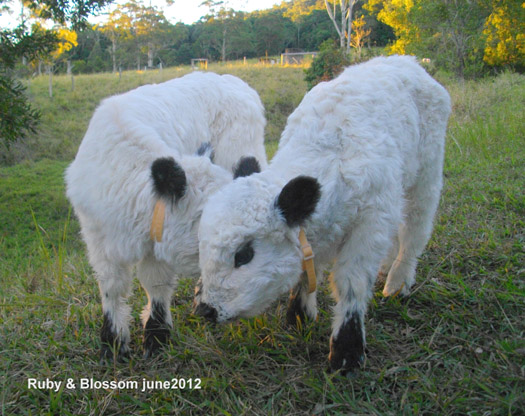
Two weeks old with tick collars on to protect them from paralysis ticks (in June!)
Weaning Rings Look Cruel But Are Actually Kind
Weaning rings look terrible but we believe they are the kindest, least stressful way to wean a calf. Before we discovered weaning rings, calf weaning was always a stressful time for everyone - the cow, the calves and us! The mooing and bawling from calf and mother were heartbreaking to listen to (sometimes lasting for several days). Despite the look of them, the weaning rings do not hurt the calf at all and they do not prevent them from grazing. The calf and the mother can stay together to comfort and groom one another during the weaning period. The ring just prevents the calf from suckling. We generally use the time to further bond with the calf by offering them molasses laced treats, extra brushes and lots of loving attention.
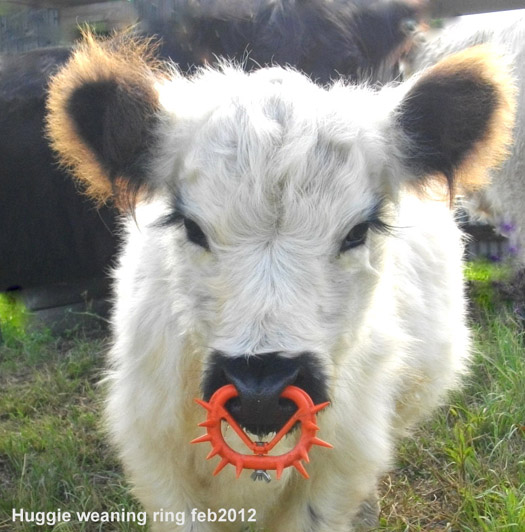
A heifer with a rather confronting looking weaning ring in her nose. It looks cruel but is a kinder way.
Reference Books: If you want further information on cattle care there are a couple of good books we have used and recommend often. Margo Hayes Small Cattle for Small Farms. Pat Coleby Healthy Cattle Naturally (now out of print but you can get Natural Cattle Care by Pat Coleby). Both books are less than $40 each.
If you would like more information on Caring for Miniature Cattle please This email address is being protected from spambots. You need JavaScript enabled to view it..
